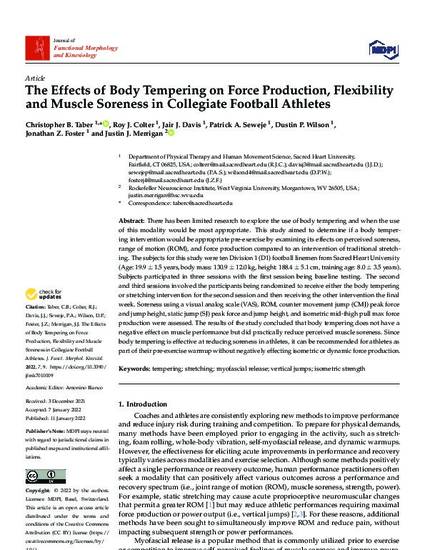
There has been limited research to explore the use of body tempering and when the use of this modality would be most appropriate. This study aimed to determine if a body tempering intervention would be appropriate pre-exercise by examining its effects on perceived soreness, range of motion (ROM), and force production compared to an intervention of traditional stretching. The subjects for this study were ten Division 1 (D1) football linemen from Sacred Heart University (Age: 19.9 ± 1.5 years, body mass: 130.9 ± 12.0 kg, height: 188.4 ± 5.1 cm, training age: 8.0 ± 3.5 years). Subjects participated in three sessions with the first session being baseline testing. The second and third sessions involved the participants being randomized to receive either the body tempering or stretching intervention for the second session and then receiving the other intervention the final week. Soreness using a visual analog scale (VAS), ROM, counter movement jump (CMJ) peak force and jump height, static jump (SJ) peak force and jump height, and isometric mid-thigh pull max force production were assessed. The results of the study concluded that body tempering does not have a negative effect on muscle performance but did practically reduce perceived muscle soreness. Since body tempering is effective at reducing soreness in athletes, it can be recommended for athletes as part of their pre-exercise warmup without negatively effecting isometric or dynamic force production.
Taber, C. B., Colter, R. J., Davis, J. J., Seweje, P. A., Wilson, D. P., Foster, J. Z., & Merrigan, J. J. (2022). The effects of body tempering on force production, flexibility and muscle soreness in collegiate football athletes. Journal of Functional Morphology and Kinesiology, 7(1), 9. Doi: 10.3390/jfmk7010008

The study was conducted according to the guidelines of the Declaration of Helsinki and approved by the Institutional Review Board of Sacred Heart University (IRB# 191219A, approved 16 January 2020).
Roy Colter, Jair J. Davis, Patrick A. Seweje, Dustin P. Wilson, Jonathan Z. Foster are students in the Department of Physical Therapy and Human Movement Science at Sacred Heart University.